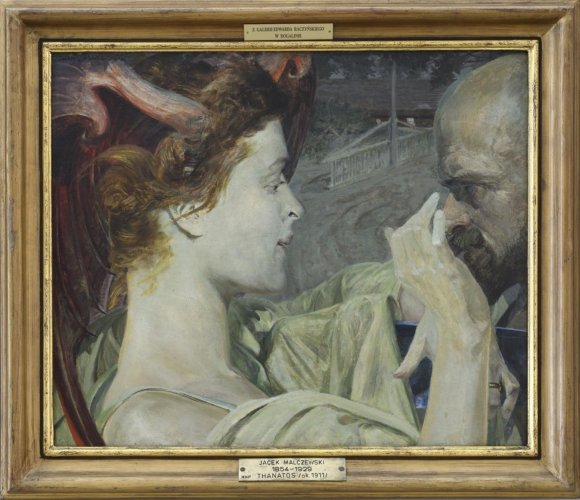Description:
Jack Malczewski (1854-1929) developed a love for art and romantic literature, particularly the poetry of Juliusz Słowacki, from his family home. He came from a szlachta family, albeit a poor one. His father Julian supported him on his path to a career in painting. The events of 1863, the January Uprising and subsequent repression, left a particularly deep mark on the young artist. His first teacher was Adolf Dygasiński. During his youth from 1867–1871 he spent time in his uncle Karczewski‘s manor in Wielgie. In 1873 he began studying at the Krakow Academy of Fine Arts under the tutelage of Jan Matejko. He was a student of Władysław Łuszczkiewicz. He also studied at the École des Beaux–Arts in Paris. He traveled to Italy, Vienna, Munich, Greece, and Asia Minor. From 1896–1900 and 1910–1914 he was a professor at the Krakow Academy of Fine Arts. From 1912–1914 he was its rector. He began with a form of idealizing realism, then moved on to naturalism, with the fate of the exiles in Siberia and the inspiration of Juliusz Słowacki‘s “Anhellim“ being a dominant theme in his works from this period. Around the same time, fantastic and allegorical elements began to appear in Malczewski‘s work. After his father‘s death in 1884, the recurring theme in Malczewski‘s work became Thanatos, the god of death. After 1890, his art became purely symbolic. Works manifesting this shift to symbolism included “Introduction“ (1890), “Melancholia“ (1890–1894), and “Vicious Cycle“ (1895–1897). The artist dealt with existential, historical, and artistic issues, weaving ancient and biblical motifs with Polish folk tales and landscapes, which were so essential to his works. His signature style was characterized by form, color, monumentality, and expression.
Description of the painting:
In the foreground we can see the silhouettes of two figures, a woman and a man filling the picture space. The specific framing draws the viewer‘s attention mainly to the ancient death god – Thanatos, depicted as an attractive woman. The angel coming for the souls of the dead is however deprived of angelic wings. The head seen from the right profile is adorned with red–brown bat wings. With her right hand she tries to delicately touch the eyelids of the man standing in front of her – Jacek Malczewski. Her left hand is casually resting on the blade of a scythe, which is hidden under the folds of her cloak.
Bats as a symbol represented an escape from the light and laws governing this world – they are active at night, sleeping with their heads down. It brings death and sorrow. In ancient Babylon, it was considered a manifestation of the deceased. In ancient Greece, it was a demonic creature that contacted the world of Hades. In Eastern tradition, bats were a symbol of immortality. The wings of a bat, meanwhile, were said to foreshadow sleep*. “Sleep, like death, will come with a leaden foot and hide the eyes with a bat‘s wing“ [“A Midsummer Night‘s Dream” W. Shakespeare].
The figure of death shown in the image does not evoke fear. “The severe, unconnected figures of angels from the first series of Thanatos are quite different from the gentle, physically beautiful women in Greek chitons of the second series.” Thanatos takes the form of Mary Balowa – the great love of the artist. “Their relationship is depicted as a common path towards knowledge, striving for existential transition, in which she is the guide.” The connection of Eros and Thanatos – love and death – draws attention to the two most important and untamed forces that govern human fate. Frequently showing death in the form of a dream companion makes its image friendly, and the expectation of its coming desired. Therefore, the artist humbly submits to her gestures. The approaching death is not a sign of the end for him, but a moment of transition to a common, eternal land of happiness.
The interpretation of this is completed by the buildings and gate in the background. In Jack Malczewski‘s works, visions of a peaceful and happy rural Arcadia usually connect with the period of his childhood spent in Wielgie. The gate guards access to the painter‘s paradise. It stands on the boundary between two spaces, internal and external, and going further – it guards the separation between the sacred and the profane. An open gate becomes a sign of transition. Leaving one world, in this case the earthly, sinful one, is synonymous with entering another, New Testament one, to attain the desired, eternal happiness.


